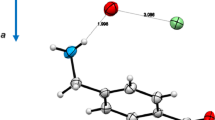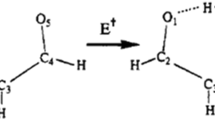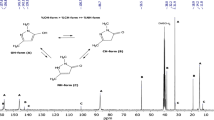Abstract
The crystal structures of two imidazole-4-imines, (E)-1-(4-chlorophenyl)-N-[1-(4-methylphenyl)-1H-imidazol-4-yl]methanimine (1, C17H14ClN3), and (E)-1-(4-bromophenyl)-N-[1-(4-methylphenyl)-1H-imidazol-4-yl]methanimine, (2, C17H14BrN3), are isomorphous, the isostructurality index is 99.4 %. Both compounds crystallize in the triclinic space group P-1 with unit cell parameters at 100(1) K as follows: for (1), a = 7.9767(5) Å, b = 10.9517(7) Å, c = 16.6753(12) Å, α = 80.522(6)°, β = 87.046(6)°, γ = 89.207(5)°, and for (2), a = 8.0720(7) Å, b = 10.9334(10) Å, c = 16.8433(13) Å, α = 81.161(7)°, β = 86.605(7)°, γ = 89.505(7)°. The structures contain two symmetry—independent but conformationally similar molecules in the asymmetric unit (Z’ = 2). In both compounds the overall twist of the molecule, defined as the dihedral angle between the terminal phenyl ring planes is significant, around 56°. The crystal packing is determined mainly be weak specific intermolecular interactions: the C–H···N hydrogen bonds connect molecules into infinite chains, and the chains are linked via C–H···X hydrogen bonds and by π–π interactions. This study illustrates the significant role of the weak interactions, which—in spite of their weakness—can robustly repeat in the crystal structures of similar compounds.
Graphical Abstract
Two imidazole-4-imines, (E)-1-(4-chlorophenyl)-N-[1-(4-methylphenyl)-1H-imidazol-4-yl]methanimine, and (E)-1-(4-bromophenyl)-N-[1-(4-methylphenyl)-1H-imidazol-4-yl]methanimine, are isomorphous, the isostructurality index is 99.4 %.

Similar content being viewed by others
Avoid common mistakes on your manuscript.
Introduction
Nucleophilic substitution of the nitroimidazole system proved to be a versatile tool for modification of the imidazole moiety [1, 2]. The presence of the nitro group, essential for the reaction mentioned, becomes not only unnecessary but it can interfere with the next potential synthetic transformation. The reduction of the nitro group, relatively easy in benzene derivatives, has proven challenging in azole systems due to metastability of the resulting amines [3, 4]. To this end the reduction and further protection of the nitro functionality appears to be an important synthetic problem.
Quite interestingly it turned out that in the Cambridge Structural Database [5] there are only a few examples of 4-aminoimidazoles. Among those there is only one imine-derivative, ethyl 5-(4-methyl-3-phenyl-3H-thiazol-2-ylideneamino)-3-propyl-3H-imidazole-4-carboxylate [6], seven diaza-compounds (e.g., series of phenylazoimidazoles [7]), and one primary, six secondary, and 12 tertiary amines. During our studies on imidazole derivatives we have determined the structures of some imidazole-4-imines. Here we report the results of the analysis of two compounds (Scheme 1, Figs. 1, 2), namely (E)-1-(4-chlorophenyl)-N-[1-(4-methylphenyl)-1H-imidazol-4-yl]methanimine, (1), and (E)-1-(4-bromophenyl)-N-[1-(4-methylphenyl)-1H-imidazol-4-yl]methanimine.
Results and Discussion
Compounds (1) and (2) are isostructural. It is possible to estimate the degree of isostructuralism using the descriptors introduced by Kálmán et al. [8] in his work on so-called “main-part” isostructuralism, or a more specific index defined by Kubicki and Szafrański [9]. The unit-cell similarity index is 0.01, very close to the ideal value of 0. Also the values of both isostructurality indices are close to the ideal values: according to [8] 99.3 % (ideal value 100 %), and according to [9] 0.985 (ideal value 1.0). The isostructuralism can be seen in the almost identical packing diagrams (Fig. 3).
Both compounds crystallize with two symmetry-independent molecules A and B in the asymmetric part of the unit cell. The results of the normal probability plot analysis [10, 11] for bond lengths and angles show that there are no systematic differences between the molecules, and the actual differences are only of a statistical nature: R 2 correlation factors for bond lengths are 0.95 (1) and 0.97 (2), while for bond angles: 0.97(1) and 0.97(2).
Due to the isostructurality, the discussion can be made on one of the compound only (1), the geometrical values for the second one (2) will be given in square brackets.
The bond lengths and angles pattern is typical; the short N41–C42 bonds prove the double-bond character. The intra-annular bond angles within the phenyl rings reflect the nature of the substituents, generally in accordance with the findings of Domenicano and Murray-Rust [12] and Exner and Böhm [13].
The conformation of the molecule can be described by the dihedral angles between the subsequent planar fragments: methylphenyl group (A), imidazole ring (B), \( {\text{C}}{-}{\text{N}}\quad {\text{C}}{-}{\text{C}} \) bridge (C) and halophenyl group (D). All these groups are essentially planar, maximum deviation from the least-squares plane is as small as 0.006(2) Å [0.013(3) Å]. The overall twist, defined as the dihedral angle between the terminal phenyl rings, is 55.79(9)° (56.44(8)°) in molecule A and 54.67(9)° (55.85(8)°) in molecule B. The values of the selected dihedral and torsion angles are listed in Table 1. It can be found that the ‘sense’ of the twists between the subsequent planes is the same, and the overall twist is roughly equal to the sum of the individual angles.
The crystal packing is determined mainly by the specific, directional weak interactions. The main motif, an ~ABAB~ chain along [010] direction, is created by relatively short and linear C5–H···N3 hydrogen bonds (Fig. 4; Table 2). In the high resolution structure of 1-phenyl-4-nitroimidazole [14] the topological analysis of the electron density distribution showed the critical points connected to the identical C5–H···N3 hydrogen bonds. The neighboring chains are connected along [101], the long axis of the molecule, by very weak C–H···X and C–H···π hydrogen bonds (Table 2; Fig. 5).
Experimental
Preparation of Compounds
1-(4-Methylphenyl)-4-nitroimidazole was reduced in a current of hydrogen under atmospheric pressure at room temperature in methanol as a solvent. Freshly prepared Raney nickel was used as a catalyst. The TLC analysis showed that the starting material was consumed within an hour giving an undefined intermediate. The reaction was carried out until the entire intermediate compound was reacted out—usually 6 h. After filtering off the metal catalyst, because of its reactivity [2, 3], the resulting amine, was not worked out but immediately treated with aromatic aldehydes. The addition of a catalytic amount of acetic acid caused the precipitation of the corresponding Schiff’s bases in good yields.
Crystallography
Diffraction data were collected at 100(1) K by the ω-scan technique on an Agilent Xcalibur CCD-detector diffractometer with Sapphire detector and using graphite-monochromatized Mo Kα radiation (λ = 0.71073 Å). The data were corrected for Lorentz-polarization as well as for absorption effects [15]. Accurate unit-cell parameters were determined by a least-squares fit of 3,746 (1) and 5,533 (2) reflections of highest intensity, chosen from the whole experiment. The structures were solved with SIR92 [16] and refined with the full-matrix least-squares procedure on F 2 by SHELXL97 [17]. Scattering factors incorporated in SHELXL97 were used. The function Σw(∣F o∣2−∣F c∣2)2 was minimized, with w−1=[σ2(F o)2 + (A·P)2 + B·P] (P = (max (F 2o , 0) + 2F 2c )/3). The final values of A and B are listed in Table 1. Anisotropic atomic displacement parameters were refined for all non-hydrogen atoms. The hydrogen atoms were placed in geometrically idealized positions, and refined as rigid groups with their U iso’s as 1.2 or 1.5 (methyl) times U eq of the appropriate carrier atom. Programs XP [17] and Mercury [18] were used for graphic representations, used in Figures. Relevant crystal data are listed in Table 3, together with refinement details.
Crystallographic data (excluding structure factors) for the structural analysis have been deposited with the Cambridge Crystallographic Data Centre, Nos. CCDC-866146 (1) and CCDC- 866147 (2). Copies of this information may be obtained free of charge from: The Director, CCDC, 12 Union Road, Cambridge, CB2 1EZ, UK. Fax: +44(1223)336-033, e-mail:deposit@ccdc.cam.ac.uk, or www: www.ccdc.cam.ac.uk.
References
Swierczek K (1996) PhD Thesis, Silesian University of Technology, Gliwice
Wagner P (1999) PhD Thesis, Silesian University of Technology, Gliwice
Suwinski J, Walczak K (1994) Pol J Chem 68:675
Suwinski J, Wagner P (2000) Pol J Appl Chem 44:31
Allen FH (2002) Acta Crystallogr B58:380
Eltsov OS, Mokrushin VS, Rybalova TV, Gatilov YuV, Tkachev AV (2000) Mendeleev Commun 10:233
Anulewicz R, Maciejewska D (1996) Pol J Chem 70:742
Kálmán A, Argay G, Scharfenberg-Pfeifer D, Höhne E, Ribár B (1991) Acta Crystallogr B47:68
Kubicki M, Szafrański M (1998) J Mol Struct 446:1
Ibers JA, Hamilton WC (eds) (1974) International tables for X-ray crystallography, vol IV. Kluwer, Dodrecht, p 293
Abrahams SC, Keve ET (1971) Acta Crystallogr A27:157
Domenicano A, Murray-Rust P (1979) Tetrahedron Lett 24:2283
Exner O, Böhm S (2002) Acta Crystallogr B58:877
Kubicki M, Borowiak T, Dutkiewicz G, Souhassou M, Jelsch C, Lecomte C (2002) J Phys Chem B106:3706
Agilent (2010) CrysAlis PRO. Agilent Technologies, Yarnton
Altomare A, Cascarano G, Giacovazzo C, Guagliardi A (1993) J Appl Crystallogr 26:343
Sheldrick GM (2008) Acta Crystallogr A64:112
Macrae CF, Bruno IJ, Chisholm JA, Edgington PR, McCabe P, Pidcock E, Rodriguez-Monge L, Taylor R, van de Streek J, Wood PA (2008) J Appl Crystallogr 41:466
Open Access
This article is distributed under the terms of the Creative Commons Attribution License which permits any use, distribution, and reproduction in any medium, provided the original author(s) and the source are credited.
Author information
Authors and Affiliations
Corresponding author
Rights and permissions
Open Access This article is distributed under the terms of the Creative Commons Attribution 2.0 International License (https://creativecommons.org/licenses/by/2.0), which permits unrestricted use, distribution, and reproduction in any medium, provided the original work is properly cited.
About this article
Cite this article
Skrzypiec, H., Mazurek, R., Wagner, P. et al. Isomorphism in Two (E)-1-(4-Halophenyl)-N-[1-(4-Methylphenyl)-1H-Imidazol-4-yl]Methanimines (Halide = Cl, Br). J Chem Crystallogr 42, 1036–1041 (2012). https://doi.org/10.1007/s10870-012-0354-1
Received:
Accepted:
Published:
Issue Date:
DOI: https://doi.org/10.1007/s10870-012-0354-1










